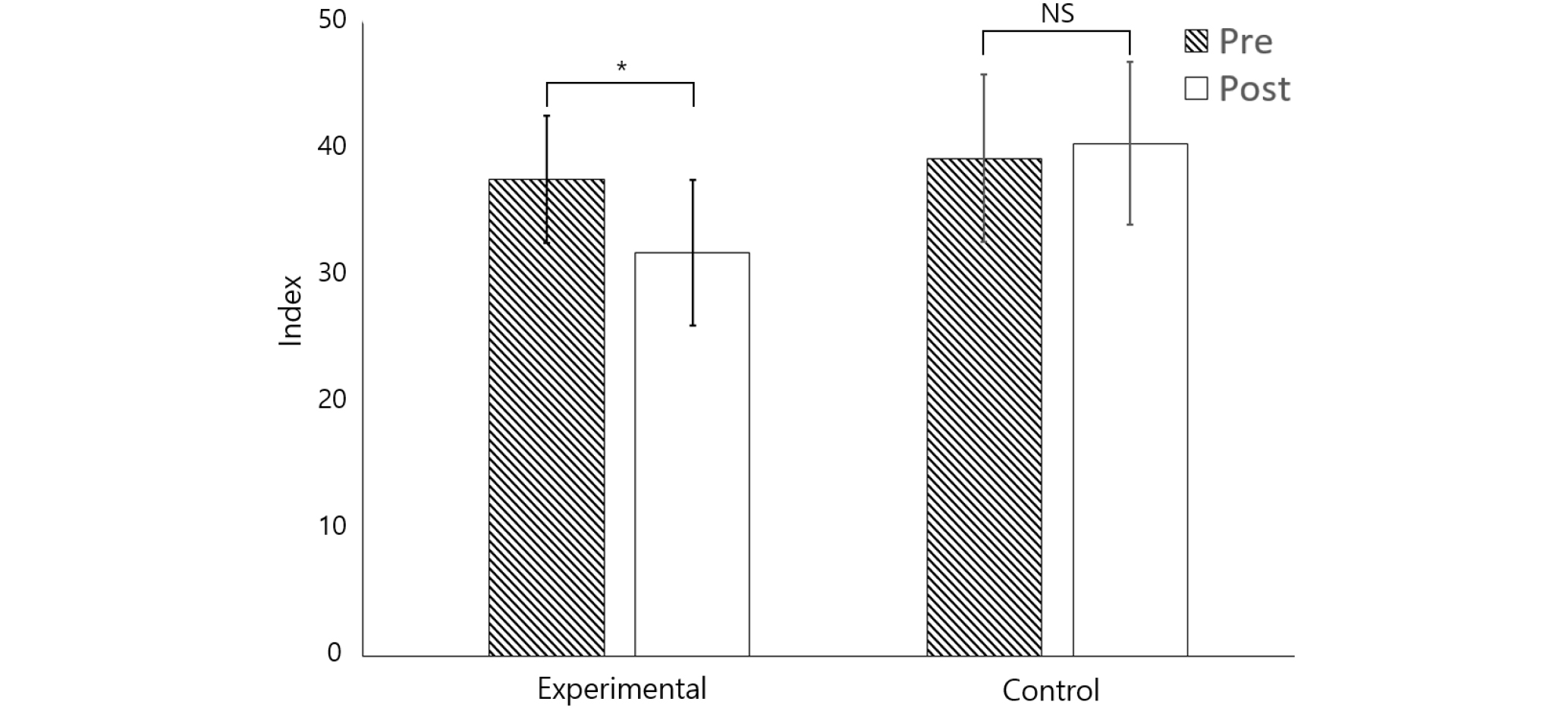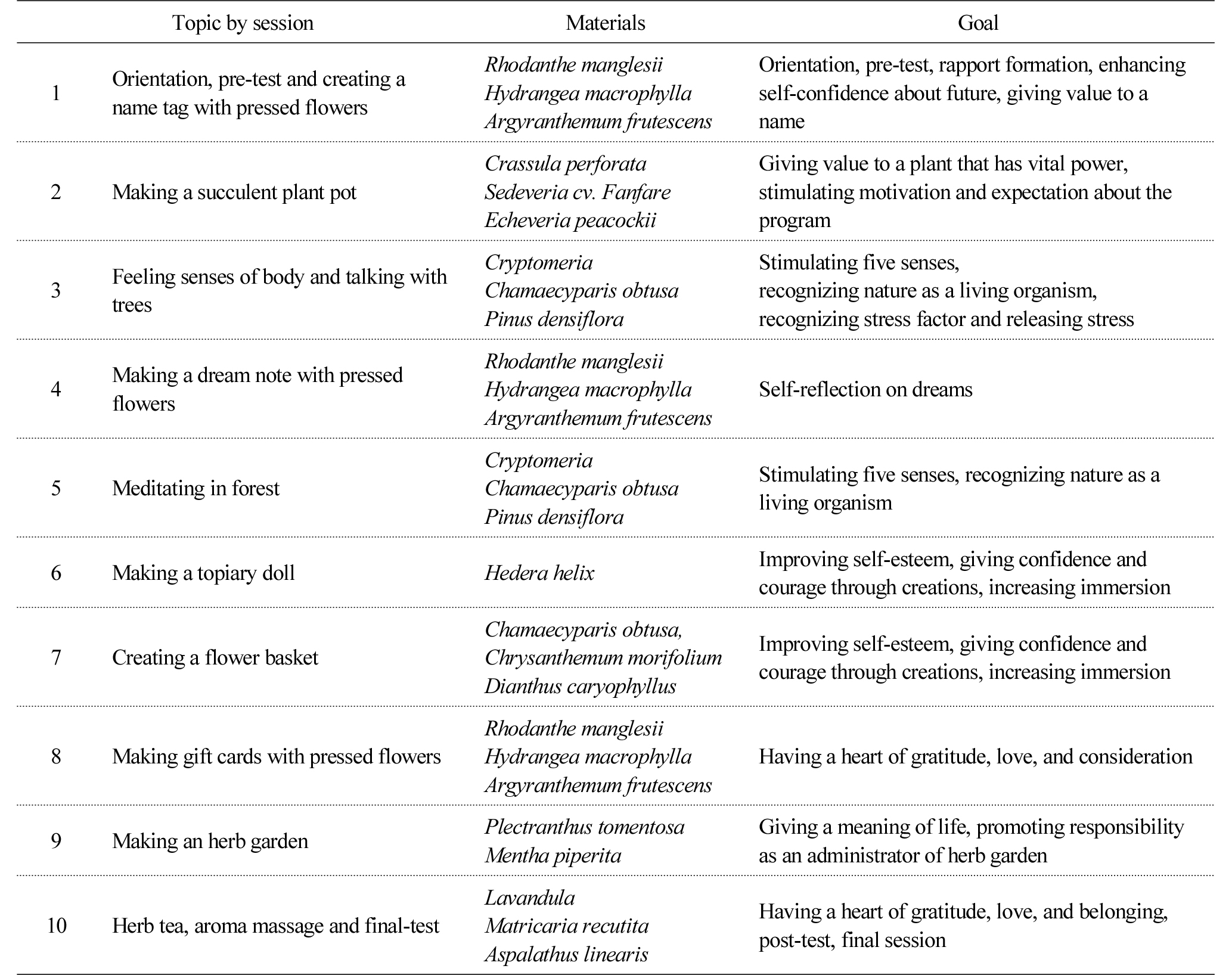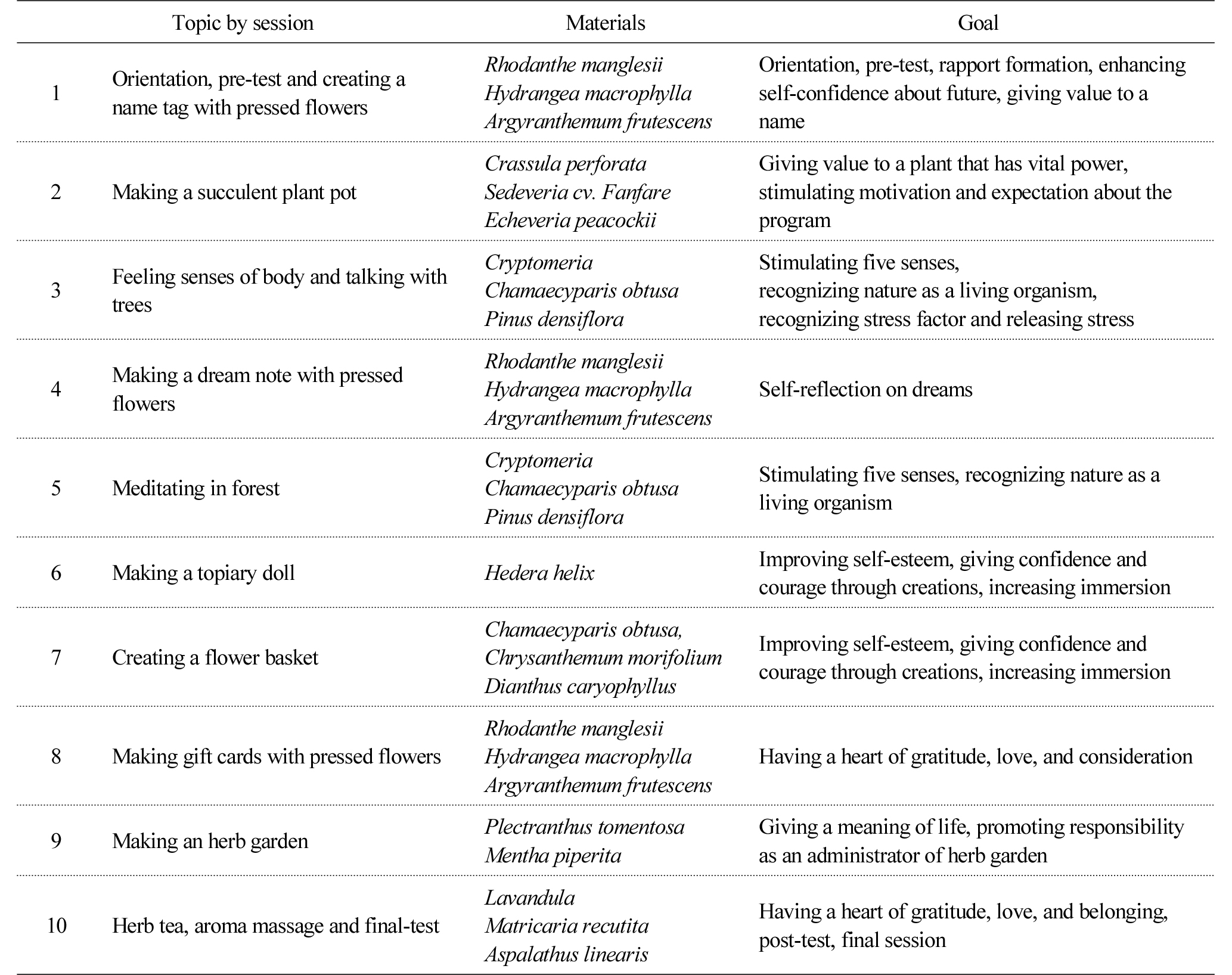Effects of Plant Mediated Therapy Activity on College Students’ Academic Burnout and Stress
Article information
Abstract
The purpose of this study was to assess the effects of plant mediated therapy on college student’s academic exhaustion and stress. The program is composed of horticultural therapy activities and forest therapy activities that improve self-encouragement level and sense of self-esteem and relieve stress. The horticultural therapy program, which consisted of eight sessions of 10 sessions, was held in the lecture hall of G university, and the forest therapy program, consisting of the remaining sessions, were held in M mountain near G university. One lead researcher and one assistant researcher conducted program activities for an hour and a half each week from September 1 to November 10. The experimental group and the control group measured their self-encouragement, academic exhaustion, academic stress, and cumulative stress before and after the program. The pre- and post- test results of the plant mediated therapy program showed significant difference in the academic exhaustion (p=.023), academic stress (p=.025), and cumulative stress (p=.027). However, there was no significant difference in self-encouragement test results. Based on these results, it was found that plant mediated activities positively affect college students’ academic exhaustion and stress.
Introduction
Burnout is a condition of feeling discouraged and worn out while devoting oneself to something, described as an excessive demand on energy or strength resulting in loss of will, emotional exhaustion and depletion (Freudenberger, 1974). Earlier studies on burnout were mostly conducted on service workers engaged in emotional labor, but recently the scope has been expanded to studies on students whose principal task is to study (Schaufeli and Taris, 2005). Academic burnout, which is an extension of the concept of burnout, refers to the state of emotional exhaustion and cynicism about studies, and lack of academic confidence or achievement (Yang, 2004; Gan et al., 2007). Students experiencing academic burnout face difficulty and coldness in their studies, which may lead them to lose their academic motivations and discontinue their studies (Lee, 2009). In particular, university students are pressured by the so-called ‘qualifications’ required in employment, and they suffer academic stress from having to earn good grades and credits that are most closely related (Lee, 2016). Excessive academic stress has negative effects on physical health such as headache, abdominal pain, fatigue and dizziness, as well as mental health such as depression, anxiety, suicide and insomnia (M.H. Kim, 2014; P.N.R. Kim, 2014; H.J. Park, 2015).
Accordingly, studies are conducted to reduce students’ stress in the field of cognitive behavioral therapy, meditation, sports for all, and drama therapy, as well as to manage stress by having students encounter garden plants or participate in horticultural activities to manage stress (Hong, 2016). Horticultural activities bring composure and emotional stability in daily life, and make people feel relaxed and comfortable just by taking a look at plants as the natural green of the plants provides contrast with the gray of the city (Seo and Lee, 2004). With the expansion of the research fields on plant- mediated therapy programs such as horticultural activities, interest in forest therapy as also increased recently.
Forest therapy includes natural and environmental resources as well as physical and psychological resources to cope with stress, thereby buffering the negative effects of stress, and encounter with nature performs a key role in maintaining and promoting psychological stability and physical health of humans (H.S. Park, 2015). Kaplan and Kaplan (1989) emphasized the importance of forests by referring to them as ‘restorative environment’ that restores fatigue from the urban environment without intentional effort.
As such, plant-mediated programs such as horticultural or forest activities perform a crucial role in maintaining and promoting physical and mental health of humans. Therefore, this study will conduct a plant-mediated therapy program combining horticultural and forest therapy for university students and determine the effects on their academic burnout and academic stress.
Method
Subjects and method
Subjects
The subjects of this study are 15 students in the experimental group and 15 students in the control group attending G University located in Jinju, Gyeongsangnam-do. These 30 students were selected among those who wanted voluntary participation from the announcement recruiting the subjects posted on the bulletin boards on campus and the university’s website. Their prior consent is obtained after selection, and we conducted an experiment of plant-mediated therapy to reduce academic burnout and stress. One from the experimental group and one from the control group withdrew during the experiment, and thus total 28 subjects participated. Table 1 shows the demographic characteristics of the subjects. This study was approved by the institutional review board (IRB NO.GIRB-A17-Y-0031) of the university.
Design and program implementation
The program in this study consists of plant-mediated therapy activities for self-encouragement, confidence and stress relief, designed to measure how these affect self-encouragement, academic burnout, academic stress, and cumulative stress of university students. The pretest and posttest were conducted after dividing the subjects into the experimental group and control group (Table 2). The program was carried out in total 10 sessions in a lecture hall of G university and M mountain near G university from September 1 to November 10, 2017 for an hour and a half every week.
Plant-mediated therapy program
The program was carried out in total 10 sessions combining horticultural and forest therapy activities (Table 3). Each session is in the introduction, development and finishing stage. In the introduction, the principal therapist provides clues and questions about the contents of the program to be implemented that day. This process was to induce curiosity and interest of the subjects so that they can predict what kind of activity will begin. The development stage is when the subjects were to directly participate in the activities. They are given detailed explanations about the activities so that they can easily understand the contents and information, and are also shown the process of how the works are created. The program was assisted by asking adequate questions and showing interest so that the subjects that do not fit in with others or show a passive attitude can participate well in the program. In the finishing stage, the subjects introduced their works to one another and complimented on others, wrapping up the session by sharing their reviews of the activities.
The forest therapy activities among total 10 sessions of the program began in the fall, and thus they were included in sessions 3 and 5 that are at the beginning and the middle part of the program considering the weather getting cold, while all the other sessions were of horticultural therapy activities. The goal of sessions 3 and 5 consisting of forest therapy activities was to stimulate the five senses and sensitivity of the subjects, helping them feel the nature and perceive it as a living organism. They could also perceive their stress and learn to express it in the process of talking to a living tree, and relax their tense muscles and relieve stress through the body scan.
Sessions 1, 4, 8 and 10 were designed for the subjects to form rapport and feel love and gratitude through horticultural activities, and to discover their role by objectively reflecting on themselves. Kim (2002) stated that horticultural activities are the process of increasing pleasure, joy, self-esteem, confidence and desire for knowledge of humans. Sessions 2, 6, 7 and 9 included activities to promote concentration by engaging in making creative works. The program was designed in a biweekly pattern to balance the formation of rapport and promotion of concentration and self-esteem depending on the purpose of the therapy.
Measurement tools
① Demographic variables
The demographic variables in this study consist of 3 items: gender, year and grade.
② Self-encouragement
Based on the previous study (Lingg and Wilborn, 1992) that encouragement and disappointment in the self- encouragement-disappointment scale developed by Noh and Jeong (2007) must be distinguished in two different concepts instead of putting them along the same line, we used only 30 items of self-encouragement excluding 30 items of disappointment. This scale consists of 10 items each for 3 sub-factors of cognitive, behavioral and emotional self- encouragement. The items are rated on a 5-point Likert scale, with higher scores indicating higher self-encouragement. The Cronbach α coefficient of the measurement tool is .96.
③ Academic burnout (Maslach Burnout Inventory-Student Survey: MBI-SS)
Academic burnout of students was measured with the MBI-SS developed by Schaufeli et al. (2002) for university students and validated by Shin et al. (2011) for Korean students. The scale consists of total 15 items rated on a 5-point Likert scale: 5 in exhaustion, 4 in cynicism, and 6 in inadequacy. Inadequacy was obtained by reverse scoring after measuring adequacy, with higher scores indicating stronger tendency of academic burnout. The Cronbach α coefficient of the measurement tool is .88.
④ Academic stress
Academic stress was measured by the questionnaire modified and improved by Kang (2014) to meet the purpose and subjects of research based on the study results of Oh and Cheon (1994). Considering that the contents are negative, a factor analysis was conducted after reverse coding of all items of academic stress. There are total 14 items of academic stress: 5 in expectation, 5 in internalization, and 4 in expression. They were rated on a 5-point Likert scale, and the Cronbach α coefficient of the measurement tool is .85.
⑤ uBioClipv measurement of heart rate variability (HRV)
Cumulative stress was measured using uBioClipv 70 developed by Biosense Creative, a Korea Institute of Science and Technology venture business. The subjects were measured before the first session of the plant-mediated therapy program on September 1, 2017 and after session 10 on November 10. They were to place their forefingers in the device sitting in a chair and measured for 2 minutes and 30 seconds. Cumulative stress can be determined by analyzing the cardiomotility and HRV, with higher scores indicating more cumulative stress.
Data analysis
The following statistical analysis is conducted to determine the effects of the plant-mediated therapy program on self-encouragement, academic burnout, academic stress, and cumulative stress of university students. The Mann-Whitney test was used to verify the homogeneity of the two groups before the program, and the Wilcoxon Signed-Rank test was used for pre-test and post-test. IBM SPSS 24 was used for all statistical analysis.
Results and discussions
Homogeneity test between the study groups
The Mann-Whitney test was conducted to determine the homogeneity of the experimental group and control group regarding self-encouragement, academic burnout, academic stress, and cumulative stress. The result showed that the items were not statistically significant, and thus the homogeneity of the two groups was verified (Table 4).
Effects of plant-mediated therapy activities on self-encouragement
Table 5 shows the result of the self-encouragement test of the experimental-control group before and after the program to analyze the effects of the plant-mediated therapy program. Self-encouragement in the experimental group (p=.162) did not show a statistically significant difference, and neither in the pretest and posttest result of the control group (p=.507). According to Bahlmaan and Dinter (2001), the result of a program promoting self-encouragement showed that self-worth, psychological well-being and positive emotions of adult participants increased, whereas anxiety, depression and compulsion decreased. This study showed different results from previous studies due to the psychological response of the subjects.
The subjects promised themselves to tend the herb garden or succulent pots they made in order to encourage themselves during the program. They also read the positive messages written on their pots once a day. Those who kept the promise of taking good care of the plants and reading positive messages perceived themselves to have done a good job taking care of their plants and thus their self-encouragement increased as they reflected on the positive messages. However, those who did not take good care of their plants showed guilt and despair for failing. Due to the awareness that they failed to keep their own promise rather created negative emotions more than the anticipated positive response. This may have brought conflicts among the factors, thereby affecting the result of self-encouragement. According to Ju (2013), parents that fail to properly perform their roles in childcare feel more guilt and stress as they are pressured by not taking good care of their children.
Effects of plant-mediated therapy activities on academic burnout
Table 6 shows the result of the academic burnout test of the experimental-control group before and after the plant-mediated therapy program. The experimental group showed a significant difference in the result of academic burnout (p=.023), whereas the control group did not (p=.694). This may be due to the fact that the participants could be separated from their helplessness, sense of loss or defeat about their studies in the process of participating in the plant-mediated therapy activities. Moreover, their engagement increased in the process of making creative works with their special significance, and their self-esteem, confidence and self-respect increased as they can do something on their own during the process, thereby showing positive effects. Choi (2003) stated that horticultural therapy can increase social interaction, physical activities, psychological stimulation, natural expression, self-esteem and voluntary activities.
Effects of plant-mediated therapy activities on academic stress
Table 7 shows the result of the academic stress test of the experimental-control group before and after the plant- mediated therapy program. The experimental group showed a significant difference in the result of academic stress (p=.025), whereas the control group did not (p=.361). This is because the participants perceived the cause of their stress through the plant-mediated therapy program and learned how to efficiently manage their stress factors. In particular, group members had complained about the travel range in the forest during the forest therapy activity, but by the finishing stage of Session 5, they confessed that just being in a forest relieves their stress and makes them feel refreshed. According to Kaplan and Kaplan (1989), people today suffer from mental and physical pain because they lack contact with nature due to the complicated city life, and forests provide psychological stability and restoration like a resting place. Jeon (2012) reported that phytoncide, the substance discharged by trees as a resistance to pathogen, injurious insects and mold, lowers the blood concentration of cortisol created when stressed, thereby reducing stress and increasing immunity.
Effects of plant-mediated therapy activities on cumulative stress
Figure 1 shows the result of measuring cumulative stress with uBioclipv before and after the plant-mediated therapy program. The mean score of cumulative stress decreased from the pretest mean (M=37.21±6.795) to post-test mean (M=31.50±5.680) in the experimental group, showing a statistically significant difference (p=.027). On the other hand, the mean score in the control group increased from the pretest mean (M=38.85±6.514) to post-test mean (M=40.00± 6.348), without showing a significant difference (p=.248). The result showed that 10 sessions of the program had effects on reducing cumulative stress of university students.

Comparing cumulative stress between experimental group and control group before and after plant mediated therapy activity. Pre=pre plant mediated therapy; Post=post plant mediated therapy. Data represent the mean ± SD (Significant as compared to Pre. *p 〈 .05, NSnon-significant by Wilcoxon signed-rank test).
Conclusion
This study was conducted to determine the positive effects of a plant-mediated therapy program combining horticultural and forest therapy on academic burnout and stress of university students. As a result of carrying out 10 sessions of the plant-mediated therapy program with 28 university students, there was no statistically significant difference in the self-encouragement scale for both the control group and experimental group (p=.162). Academic burnout did not show a significant difference in the control group, but showed a significant difference in the experimental group (p=.023). Academic stress did not show a significant difference in the control group, but showed a statistically significant difference in the experimental group. The additional analysis of cumulative stress also showed a significance difference before and after the program in the experimental group like academic stress.
The result of this study showed that the plant-mediated therapy activity combining horticultural and forest therapy was effective in reducing academic burnout, academic stress, and cumulative stress of university students. There are limitations in generalizing the results because the sample size was small, but the significance is in applying a program that combined horticultural and forest therapy, which has not been generally discussed in the field of research on horticultural and forest therapy. It is necessary to analyze the stress differences before and after the program for university students with high scores in academic burnout instead of general university students for more detailed analysis.













